
Network of Scientific Journals from Latin America and the Caribbean, Spain and Portugal

Structural and functional conditions of bridges and viaducts on federal highways in Pernambuco
Condições estruturais e funcionais de pontes e viadutos das rodovias federais de Pernambuco
Condiciones estructurales y funcionales de puentes y viaductos de las vías federales de Pernambuco
Structural and functional conditions of bridges and viaducts on federal highways in Pernambuco
Revista de la Asociación Latinoamericana de Control de Calidad, Patología y Recuperación de la Construcción, vol. 8, no. 1, 2018
Asociación Latinoamericana de Control de Calidad, Patología y Recuperación de la Construcción, A. C.
Received: 15 June 2017
Accepted: 09 November 2017
Published: 31 January 2018
Abstract: This paper discusses the structural and functional conditions of 332 bridges and viaducts on federal highways in Pernambuco, adopting as a methodology the database of the National Department of Infrastructure of Transportation (DNIT) and structural inspections on a selected sample. The information obtained was analyzed according to the criteria of DNIT Standard 010/2004 – PRO and ABNT Standard NBR 9452/2016. It is the first survey in Brazil with such a large quantity of structures utilizing two normative systems. Even with the limitations present in this type of study, the conclusions show that it is a significant contribution to the improvement of Brazilian highways bridges that, in general, suffer from the same problems that were found in the bridges analyzed.
Keywords: pathological manifestations, structures, inspection, bridges and viaducts.
Resumo: Este artigo tem como objetivo discutir as condições estruturais e funcionais de 332 pontes e viadutos das rodovias federais de Pernambuco, adotando-se como metodologia a consulta ao banco de dados do Departamento Nacional de Infraestrutura de Transportes (DNIT) e inspeções nas obras que constituem a amostra estudada. As informações obtidas foram analisadas conforme os critérios da norma DNIT 010/2004 – PRO e da norma ABNT NBR 9452/2016. Trata-se da primeira pesquisa no Brasil com tal quantidade de obras utilizando dois sistemas normativos. Mesmo com as limitações inerentes a esse tipo de estudo, as conclusões mostram que ele significa uma contribuição para a melhoria das pontes rodoviárias brasileiras que, de modo geral, padecem dos mesmos problemas existentes nas pontes analisadas.
Palavras-chave: manifestações patológicas, estruturas, inspeção, pontes e viadutos.
Resumen: El presente trabajo tiene como objetivo analizar las condiciones estructurales y funcionales de 332 puentes y viaductos de las autopistas Federales de Pernambuco, adoptando como metodología la base de datos del Departamento Nacional de Infraestructura del Transporte (DNIT) y las inspecciones estructurales que constituyen la muestra estudiada. La información obtenida se analizó según los criterios de la norma DNIT 010/2004 - PRO y la norma ABNT NBR 9452/2016. Siendo la primera investigación en Brasil con tal cantidad de estructuras usando dos sistemas normativos. Aunque con las limitaciones de este tipo de estudio, las conclusiones muestran que significa una contribución al mejoramiento de los puentes de carreteras brasileños que, en general, sufren los mismos problemas que existen en los puentes analizados.
Palabras clave: manifestaciones patológicas, estructuras, inspección, puentes y viaductos.
INTRODUCTION
In the 1970s, Brazil went through the so-called economic miracle (Cunha, 2011), which promoted the acceleration of the consolidation of large multinational companies, a concrete example being the automobile industry; and the financing of public works by international institutions, as was the case with the expansion of the Brazilian road network, including a large number of bridges and viaducts. This resulted in a significant increase in vehicle flow and cargo transportation.
However, the lack of policies and strategies aimed at public works maintenance over the past few decades has allowed a process of highway deterioration to take place, directly affecting the projects known as “Special Engineering Structures,” which present a variety pathological manifestations and structural damages. Some factors have also aggravated the current situation, such as the older Brazilian norms that were in force at the time the structures were designed and constructed, which did not predict the current load or traffic intensity on highways and in urban centers. The environmental aggressiveness at the locations where the bridges were built was also not taken into account, and this theme has been covered by several scholars who have done research on the subject, such as (Vitório, Barros, 2013) and (Milani, Kripka, Pravia, 2011).
The lack of public strategies for maintenance has also generated a large gap with regard to information on the actual state of Brazil's infrastructure projects, especially the Special Engineering Structures (SES), making it imperative to carry out inspections to obtaining the critical data regarding the safety conditions and functionality of these structures.
It was in this context that the structural conditions, functionality, and durability of bridges and viaducts of the principal federal highways of Pernambuco were analyzed. In light of the results obtained in this sample, the current panorama of SES that make up the Brazilian federal highways was outlined.
DEVELOPMENT OF THE STUDY
Methodology utilized
Most of the information contained in the present study was obtained from DNIT's Special Engineering Structures Management System (SGO) database, and from detailed analyses of several bridges and viaducts located on federal highways crossing the State of Pernambuco, whose denominations are shown in Table 1 below.
A survey was also carried out to identify the construction periods and the typical mobile loads of each structure. Failure to supply most of the original designs meant that much of this information was obtained by comparing the evolution of the bridge cross-sections of federal highways over time with the mobile loads that were used on bridges built in the respective periods, as shown in Figure 1.
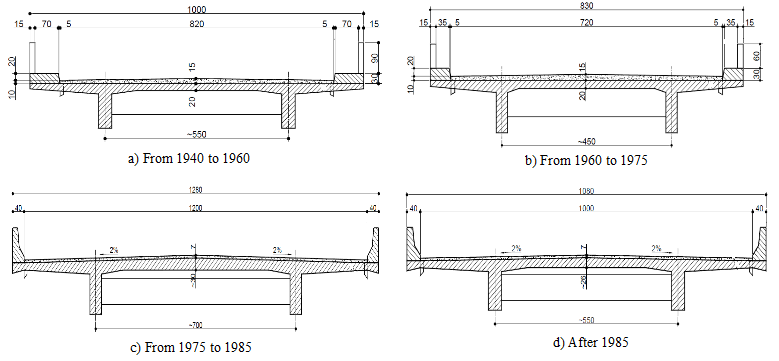
For the analyses of the structural and functional conditions, DNIT Standards 010/2004 - PRO were used, which specify the stability condition of the structure by assigning a technical grade that varies from 1 (critical structure) to 5 (structure without problems). The new version of NBR 9452 (ABNT, 2016) was also used, which introduced structural, functional, and durability parameters to guide the classification of bridge structures. The procedures foreseen in these two norms are usually adopted in Brazil to identify and diagnose the main anomalies in bridge structures, including pathological manifestations and the most frequent types of damage.
Finally, the results obtained in the research were interpreted and evaluated, in order to determine the structural and functional conditions of the SES studied and to propose solutions for the correction of existing problems, applying a more comprehensive view that can be applied not only to the bridges and viaducts of Pernambuco, but to other structure that make up the Brazilian road system as a whole.
Bridges analyzed by construction period, typical load, and construction system
Table 1 shows the federal highways within the jurisdiction of the State of Pernambuco, totaling 546 bridges and viaducts, and the amount inspected in this study, corresponding to 332 structures. This sample represents approximately 60% of all of the existing bridges in the state road network.
| Highway | SES inspected | Total SES per highway |
| BR-101 | 115 | 117 |
| BR-104 | 35 | 57 |
| BR-110 | 24 | 33 |
| BR-116 | 7 | 7 |
| BR-232 | 64 | 80 |
| BR-316 | 5 | 83 |
| BR-407 | 30 | 31 |
| BR-408 | 17 | 54 |
| BR-423 | 30 | 30 |
| BR-428 | 5 | 54 |
| Total | 332 | 546 |
The study also classified the Special Engineering Structures by period of construction (Table 2) and by the project model load, which is defined as the set of mobile loads to be applied to the structure in a position that produces the most unfavorable forces for each section and combination of loads calculated. As previously explained, the information was acquired from the SGO/DNIT and through the analysis of the evolution of the transversal cross-section of the structure, associated with the changes that occurred in the Brazilian standards specifying mobile load values over time for those projects where data from the construction time period was not available. The Special Engineering Structures for which this information could not be obtained were considered unidentified.
| Period Constructed | Total |
| 1940 to 1960 | 27 |
| 1960 to 1975 | 113 |
| 1975 to 1985 | 54 |
| 1985 to 2000 | 10 |
| After 2000 | 83 |
| Unidentified | 45 |
| Total | 332 |
Regarding the project model load, Figure 2 shows that 50.60% of the structures were qualified with 360 kN loading. The mobile loads of 450 kN, currently used, represent 28.31% and those of 240 kN represent 7.83% of the total sample. There were also 13.25% of structures whose project model loads were not possible to identify.

Regarding the constructive system, it was verified that reinforced concrete poured on-site was predominant, used in 76.20% of the bridges and viaducts. The second most prominent system was prestressed concrete, adopted in 23.19% of the structures. Pre-cast reinforced concrete accounted for 0.60%. These data are shown in Figure 3.

Pathological manifestations identified in the studied sample
In order to identify pathological manifestations, observations were made at each site during the inspections and the SGO survey reports were analyzed. The major pathological problems identified are illustrated in Figures 4, 5, 6 and 7.

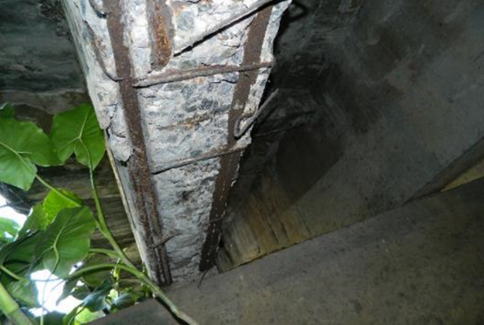
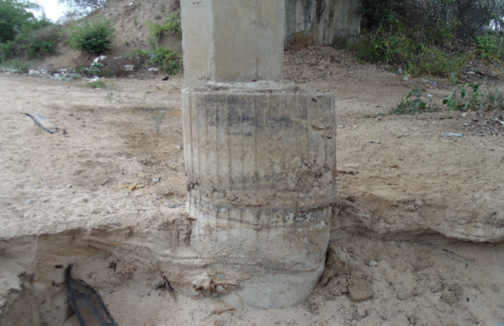

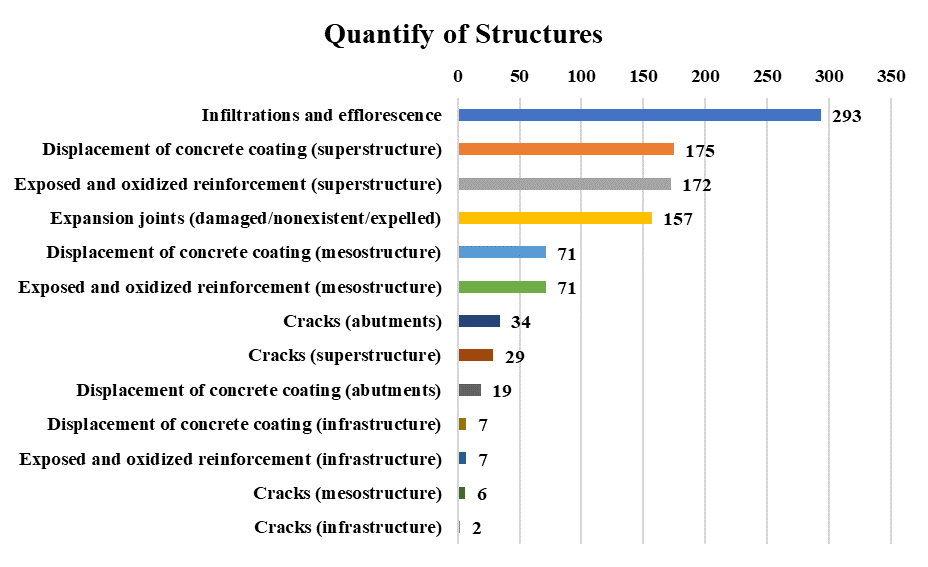
Figure 8 synthesizes the highest incidences of pathological manifestations for the evaluated set, showing the predominance of infiltrations and efflorescence, present in 293 SES. The following anomalies are also worth mentioning: displacement of the concrete (of the superstructure) in 175 structures, exposed and oxidized reinforcement (of the superstructure) in 172 structures, and damaged and/or nonexistent expansion joints in 157 SES.
Structural damage identified
Similar to the pathological manifestations, some of the main types of damage observed in the bridges and viaducts of this study are illustrated in Figures 9, 10, 11 and 12.

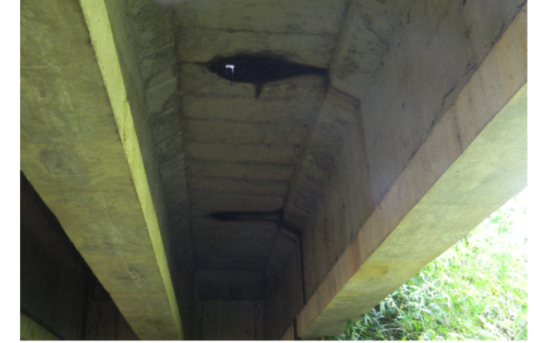
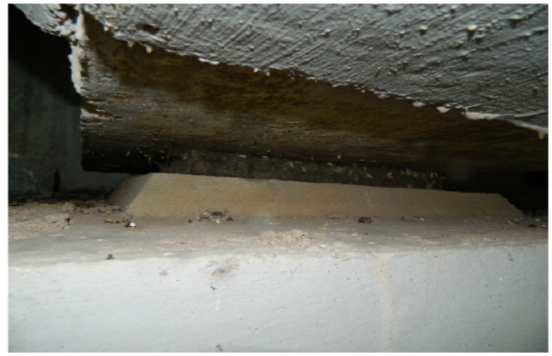
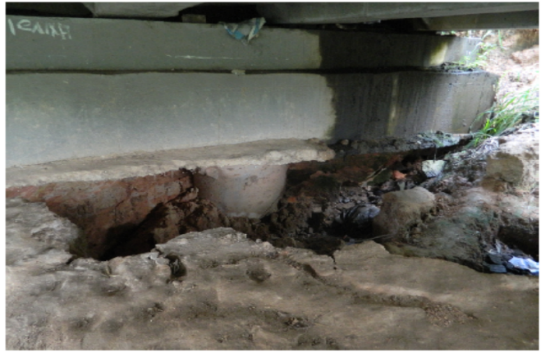
Figure 13 quantifies the principal damage types found in the analyzed set of structures. It was verified that 92 bridges had damaged and/or nonexistent drains. Next most prevalent were damaged guardrails (50 SES), followed by breakdowns in stone/concrete masonry (46 SES), as well as the lack or deficiency of bearings (25 SES), and holes in the concrete (20 SES). Other types of damage occurred less frequently.
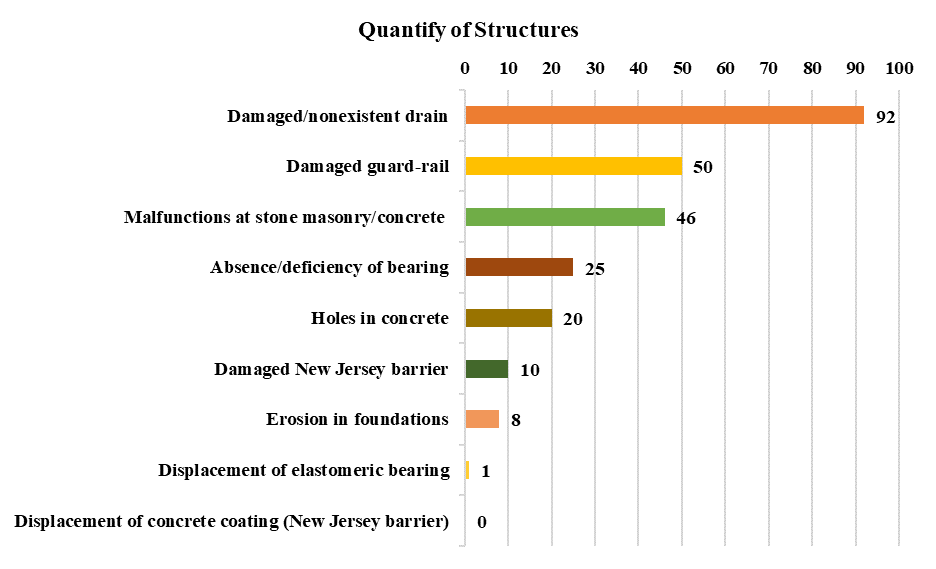
EVALUATION OF STABILITY CONDITIONS
Evaluation by DNIT Standard 010/2004 – PRO
The criteria for evaluating the structural stability conditions considered by DNIT standard 010/2004-PRO are shown in Table 3 below.
| GRADE | DAMAGE / STRUCTURAL INSUFFICIENCY | CORRECTIVE ACTION | STABILITY CONDITIONS | CLASSIFICATION OF BRIDGE CONDITIONS |
| 5 | No damage or structural deficiency | Nothing to do | Good | Structure without problems |
| 4 | Some damage, but no sign that it is causing any structural deficiency | Nothing to do beyond regular maintenance service | Good | Structure without significant problems |
| 3 | There is some damage generating structural insufficiency, but no signs of compromised stability | The recuperation of the structure can be postponed, but the problem must be systematically monitored | Apparently Good | Potentially problematic structure |
| Following the evolution of the problems through routine inspections is recommended, in order to detect any worsening of the deficiency in a timely manner | ||||
| 2 | There is damage generating significant structural insufficiency in the bridge, but there is still no apparent tangible risk of structural collapse | Recuperation (usually with structural reinforcement) of the structure must be performed in the short term | Tolerable | Problematic structure |
| Too much delay in performing recuperation could leave the structure in a critical state, possibly seriously compromising its useful life. Intermediate inspections to monitor the problems are recommended | ||||
| 1 | There is damage causing severe structural insufficiency of the bridge; the element in question is in critical condition, with a tangible risk of structural collapse | Recuperation (usually with structural reinforcement) or in some cases, replacement, must be done without delay | Precarious | Critical Structure |
| In some cases, it may constitute an emergency situation, and recuperation of the structure may be accompanied by special preventive measures, such as: bridge load restriction, total or partial traffic interdiction, provisional shoring, instrumentation with continuous displacement, deformation readings, etc. |
The application of these criteria to the sample studied is shown in Figure 14, which indicates that 156 SES can be classified as potentially problematic (grade 3), or 46.99%. It is important to note that 174 structures were evaluated as having grades between 1 and 3 (critical to potentially problematic), which is equivalent to 52.41% of the sample studied. Only 59 structures (17.77%) received a grade of 5.
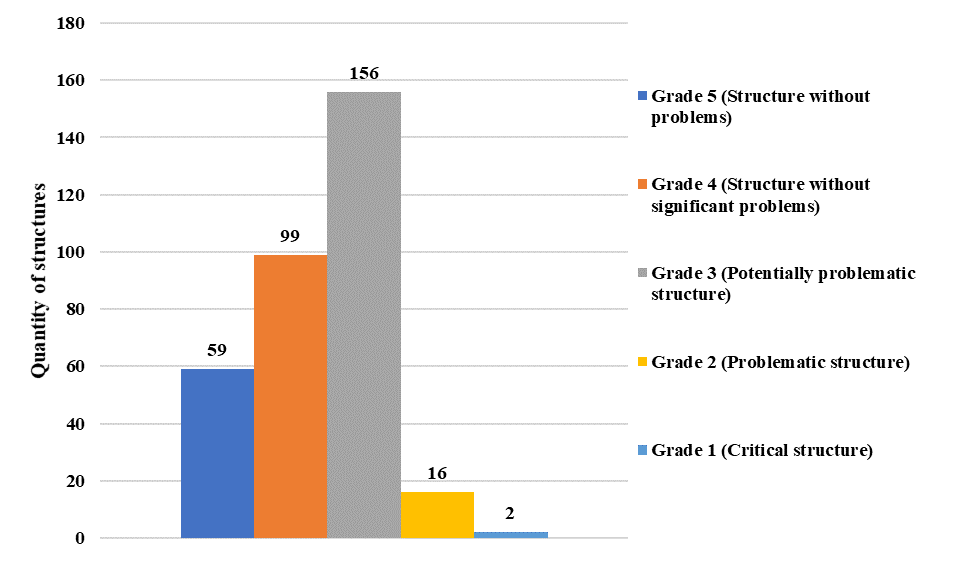
Table 4 shows the correlation between the construction period and the stability conditions. It also shows that 34% of the structures studied were built between 1960 and 1975, meaning that they are over 40 years old, while 8% are almost 70 years old.
| Construction Period | Total (BR-101, BR-104, BR-110, BR-116, BR-232, BR-316, BR-407, BR-408, BR-423, and BR-428) | ||||
| Grade (Stability condition) | |||||
| Grade 5 | Grade 4 | Grade 3 | Grade 2 | Grade 1 | |
| 1940 to 1960 | 0 | 7 | 14 | 5 | 1 |
| 1960 to 1975 | 5 | 34 | 67 | 7 | 0 |
| 1975 to 1985 | 2 | 20 | 28 | 4 | 0 |
| 1985 to 2000 | 1 | 5 | 3 | 0 | 1 |
| After 2000 | 45 | 21 | 17 | 0 | 0 |
| Unidentified | 6 | 12 | 27 | 0 | 0 |
| Total | 59 | 99 | 156 | 16 | 2 |
Evaluation by NBR 9452/2016
The structural evaluation according to NBR 9452/2016 followed the criteria shown in Table 5. In Table 6 it can be seen that, according to these criteria, a grade of 4 was most common, attributed to 116 bridges. A grade of 5 was obtained by 107 SES, followed by grade 3 (87), grade 2 (20) and grade 1 (2). By these criteria, the 113 structures built between 1960 and 1975 had scores different from those obtained by the criteria of the DNIT standard.
| GRADE | CONDITION | STRUCTURAL CHARACTERIZATION | FUNCTIONAL CHARACTERIZATION | DURABILITY CHARACTERIZATION |
| 5 | Excellent | The structure presented satisfactory conditions, with only irrelevant and isolated defects | The SES presents security and comfort to users | SES is in perfect condition and routine maintenance should be provided |
| 4 | Good | The structure has a small degree of damage, but in areas that do not compromise structural safety | The SES has minor damages that do not cause discomfort or insecurity to the user | SES presents a few small anomalies, which may compromise its useful life in a region of low environmental aggressiveness |
| 3 | Average | There are damages that may cause some structural deficiency, but there are no signs of compromising the stability of the structure. It is recommended to follow up on the problems. Interventions may be necessary in the medium term | The SES causes user discomfort, with defects that require medium-term action | SES has a few small and few anomalies that compromise its useful life, in a region of moderate to high environmental aggressiveness, or SES has many moderate anomalies that compromise its useful life, in a region of low environmental aggressiveness |
| 2 | Bad | There are damages that compromise the structural safety of the SES, but without imminent risk. It may evolve to structural collapse. SES needs significant interventions in the short term | SES with functionality visibly compromised and user security risks, requiring short term interventions | SES has moderate or many pathological manifestations, which compromise its useful life in a region of high environmental aggressiveness |
| 1 | Critical | There are damages that cause serious structural insufficiency in the SES. There are structural elements in critical condition, with tangible risk of structural collapse. The SES requires immediate intervention and may require load restriction, total or partial traffic ban, provisional shoring ,and associated instrumentation | The SES does not present functional, usable conditions | The SES is in a state of high deterioration, indicating a problem of structural and/or functional risk |
| Period of Construction | TOTAL | ||||
| Structural Condition | |||||
| Grade 1 | Grade 2 | Grade 3 | Grade 4 | Grade 5 | |
| 1940 to 1960 | 1 | 4 | 8 | 8 | 6 |
| 1960 to 1975 | 0 | 8 | 38 | 54 | 13 |
| 1975 to 1985 | 0 | 4 | 16 | 24 | 10 |
| 1985 to 2000 | 1 | 1 | 3 | 1 | 4 |
| After 2000 | 0 | 0 | 3 | 16 | 64 |
| Unidentified | 0 | 3 | 19 | 13 | 10 |
| Total | 2 | 20 | 87 | 116 | 107 |
Considerations on the analyses made by the DNIT and ABNT standards
Both standards used in this study assign a classification grade from 1 to 5 for stability conditions. The DNIT 010/2004-PRO Standard also includes concepts, inspection types, the necessary qualifications for inspectors, and the minimum frequency of surveys that allow some evaluation criteria to be defined. However, the recent revision of NBR 9452 (ABNT, 2016), in addition to adopting the concepts and guidelines contained in the DNIT standard, introduced greater flexibility by including structural, functional, and durability parameters. These parameters made inspections and classification criteria of bridges and viaducts in Brazil more realistic.
It is worth highlighting that the two standards made the diagnosis of the main pathological manifestations possible without significant differences in the evaluation of damages and other anomalies in the sample bridges.
On the other hand, when analyzing stability conditions, a considerable difference was observed in the results obtained by each of the two standards, as can be seen in Table 7.
| GRADE | DNIT 010/2004 – PRO STANDARD | STANDARD 9452 (ABNT, 2016) | ||
| SES | % | SES | % | |
| 5 | 59 | 17.77 | 107 | 32.23 |
| 4 | 99 | 29.82 | 116 | 34.94 |
| 3 | 156 | 46.99 | 87 | 26.21 |
| 2 | 16 | 4.82 | 20 | 6.02 |
| 1 | 2 | 0.6 | 2 | 0.6 |
Even considering that inspections were carried out visually, depending essentially on the experience and judgment of the inspector, the information in Table 7 shows that, with regard to grades 1 and 2, referring to structures in the worst conditions, there were no differences in the results obtained through the two standards.
However, results related to the other grades assigned (3, 4 and 5) show that analysis by NBR 9452 leads to values representing significantly better structural conditions, when compared to those obtained by the DNIT Standard. This means that several bridges and viaducts in this study that may have poor durability conditions and functionality assessments but have satisfactory structural conditions. It also means that these structures can be used without reaching the ultimate state limit. The opposite situation was also verified: bridges and viaducts classified without durability and functionality problems (grades 4 and 5) that had a low structural condition classification.
In general terms, it is possible to affirm that the new version of the ABNT standard that introduces greater variability in the evaluation parameters and applies them to a larger quantity of the elements that make up a bridge, guarantees a more consistent and more realistic evaluation than the DNIT standard, which scores only five elements and is therefore a more conservative evaluation. This is evident in the case of a Special Engineering Structure without major breakdowns that can have one of the elements evaluated with a low rating, and therefore will have the final technical grade correspond to the lowest value among those received all of the elements. This produces a conservative final assessment that does not represent the actual situation of the bridge.
In this sense, NBR 9452 (ABNT, 2016), even though it also bases its final evaluation on the lowest individual grade, introduces a greater amount of parameters for judgment and therefore is less conservative, because it determines the grades through a more comprehensive analysis. This standard also allows for a more comprehensive and realistic diagnosis of the structure, which is a breakthrough in Brazil, which lacks methods and literature to assess the safety of existing bridges, unlike other countries where sophisticated analyses are used, including probabilistic methods.
CONCLUSIONS AND RECOMMENDATIONS
The significant occurrence of structural accidents, some of a serious nature, involving the Brazilian Special Engineering Structures at the federal, state, and municipal levels, is a concrete fact that can be verified through simple observation of the news media. It is possible to conclude that the vulnerability of such structures is directly associated with the environmental aggressiveness of certain regions. Erosion processes at foundations and lack of proper maintenance also contribute to reduced safety and the need for large and costly repairs.
This study sought to contribute to the production of knowledge on this subject, which still lacks specialized literature in Brazil, based on the case study presented, showing a panorama of the current situation of the federal highway network bridges in Pernambuco, and which also represents the situation the bridges in the entire Brazilian road network.
This study showed that a key factor contributing to the occurrence and evolution of damages is the fact that many of these bridges were designed and built during times when the standards did not take into account concepts aimed at guaranteeing greater durability, and there was no knowledge of the performance of the materials used in constructions. In addition, there was a progressive evolution to the flow and weight of vehicles, with significant increase in the mobile loads transmitted to the structures, which were not originally planned for such values. These facts, coupled with the lack of conservation policies and strategies, have accelerated the evolution of the pathological problems, structural damage, and deficiency of functionality of the Brazilian Special Engineering Structures.
This study also showed that the lack of a database containing the cadastral information necessary for the management of Brazilian road network bridges has made the elaboration of precise diagnoses difficult and hindered the adoption of adequate measures to solve the structural and functional problems based on their respective priorities, since a lot of necessary information cannot be found in the SGO of the DNIT.
Even so, this work makes some recommendations that, if adopted, would contribute to the minimization of many of the problems identified in the sample studied which are repeated in other Special Engineering Structures in Brazil. The recommended interventions are shown below in order of priority, according to the frequency of occurrence found during the inspections performed. Most of these recovery and reinforcement interventions are not very complex and do not entail great costs.
- Restoration of the superstructure drainage system, due to the fact that 88.25% of the bridges analyzed had infiltrations and efflorescence in the deck concrete and 27.71% had damaged and/or destroyed drains.
- Recuperation with the application of a concrete layer over the bridge deck, since 52.71% of the sample bridges showed concrete displacement.
- Treatment and/or replacement of corroded reinforcements, which were found in 51.81% of the structures inspected.
- Replacement of damaged or destroyed New Jersey barriers and guardrails, observed in 18.07% of the bridges studied.
- Correction of joint failures, many caused by differential pressure and erosion, found in 16.26% of the bridges. In such cases, it is necessary to carry out geotechnical and hydrological studies to verify the safety of the foundations and the flow section, to determine the necessity of reinforcement and protection against erosion.
- Replacement of damaged expansion joints, responsible for the appearance of pathological manifestations and structural damage in 47.29% of the studied structures.
- Replacement of damaged support units responsible for changes in the transmission of the forces on the bridge deck to the mesostructure, occurring in 7.53% of the bridges.
- Correction of miscellaneous damages such as holes in the concrete, small cracks, and displacements in secondary elements of most bridges surveyed.
The recommendations above should be the focus of projects prepared by specialized professionals and executed by companies with experience in recovery and reinforcement of bridge structures. In the most problematic bridges (those with grades 1 and 2), the first step should be a numerical analysis to measure structural safety and define the need and type of reinforcement.
Another issue that must be considered of fundamental importance in guaranteeing the safety of bridges and viaducts in Brazil is the implementation of management systems at the federal, state, and municipal levels that will allow for the registration of structures, routine inspections, advanced monitoring techniques, and the definition of intervention priorities. Budget resources must also be guaranteed to enable conservation actions to take place before damage develops and worsens exponentially, as it currently occurs.
It must not be forgotten that the Brazilian road network continues to expand, making it necessary to design high quality projects that, in addition to concepts and materials adequate to guarantee a longer useful life, also include appropriate devices to facilitate inspections and preventive maintenance.
Finally, it is possible to conclude that the results obtained from this research, even though referring only to the federal road network in Pernambuco, show the current conservation situation of the Brazilian highway Special Engineering Structures as a whole, and are consistent with studies performed by other authors that analyzed much smaller samples of bridges.
Acknowledgements
The authors are grateful to the Polytechnic School of the University of Pernambuco, as well as to the National Department of Transportation Infrastructure (DNIT) for allowing access to data and providing information on the bridges studied in this research project.
REFERENCES
Associación Brasileña de Normas Técnicas (2016), NBR 9452: inspección de puentes, viaductos e passarelas de concreto - procedimento. Rio de Janeiro.
Cunha, A. A. (2011), Estudio das patologias em obras de arte especiales do tipo puentes e viaductos estructurados em concreto. 152p. Proyecto final de curso (Bacharel em Engenharia Civil) – Universidade Estadual de Goiás, Goiania.
Departamento Nacional de Infraestructura de Transportes (2004). Norma DNIT 010/2004 – PRO: inspecciones em puentes e viaductos de concreto armado e pretensado – procedimento. 1.ed. Rio de Janeiro.
Meyer, K. F. (1996), Passarelas e pontes para dutos. 2. ed. Belo Horizonte: RONA. 243p.
Milani, C., Kripka, M., Pravia, Z. (2015), Monitoramento de puentes. Revista Infraestructura urbana. PINI: Sao Paulo, 16. ed, 2011. Disponível em: http://Infraestructuraurbana.pini.com.br/solucoes-tecnicas/16/artículo260592-1.aspx. Acesso em: 12 abr. 2015.
Silva, C. J. G. (2016), Uma muestra das condiciones estructurales e funcionales de puentes e viaductos das vías federales de Pernambuco. Dissertación de Mestrado, Universidade de Pernambuco.
Vitório, J. A. P., de Barros, R. M. M. C. (2013) Análisis dos daños estructurales e das condiciones de estabilidad de 100 puentes rodoviárias no brasil. In: Congresso da Associación Portuguesa Para a Seguridad e Conservación de Puentes, 3, 2013, Porto. Anais... Porto, 9p.
Additional information
Cite as: C. J. G. Silva, E. Monteio, J. P. A. Vitório
(2018), “Structural and functional
conditions of bridges and viaducts on federal highways in Pernambuco”,
Revista ALCONPAT, 8 (1), pp. 79 – 93. DOI: 10.21041/ra.v8i1.199
Legal Information: Revista ALCONPAT is a quarterly publication of
the Latinamerican Association of quality control, pathology and recovery of
construction- International, A. C., Km. 6, antigua carretera a Progreso,
Mérida, Yucatán, C.P. 97310, Tel.5219997385893, alconpat.int@gmail.com , Website: www.alconpat.org
Editor: Dr. Pedro Castro Borges. Reservation of rights to exclusive
use No.04-2013-011717330300-203, eISSN 2007-6835, both awarded by the National
Institute of Copyright. Responsible for the latest update on this number,
ALCONPAT Informatics Unit, Ing. Elizabeth Sabido Maldonado, Km. 6, antigua
carretera a Progreso, Mérida, Yucatán, C.P. 97310.
The views expressed by the authors do not
necessarily reflect the views of the publisher.
The total or partial reproduction of the
contents and images of the publication without prior permission from ALCONPAT
International A.C. is not allowed.
Any discussion, including authors reply, will
be published on the third number of 2018 if received before closing the second
number of 2018.